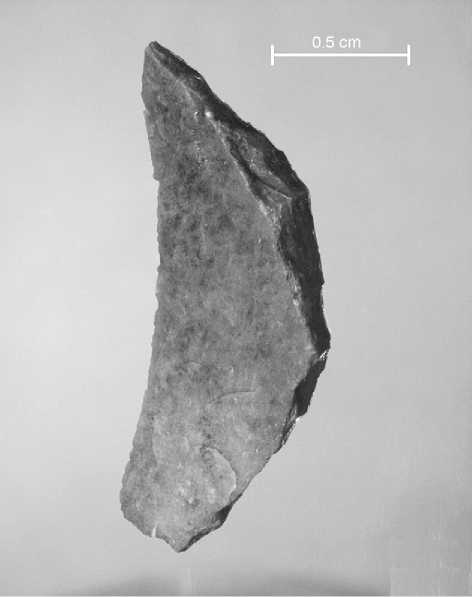The increase in occupation sites and rates of artifact discard that occurred after c. 5 ka in Australia have been viewed by some to also signal increased social complexity in social systems, or a trend to ‘intensification’ and in some places a move to more permanent occupation of particular areas. One of the apparent markers of this change is the presence of backed artifacts: small crescent or segment shaped tools which are triangular in cross section, either symmetrical or asymmetrical, with blunting retouch on the thicker margin opposite the cutting edge (see below).
OF increasing interest and apparent complexity are the changes now documented through the Holocene period, particularly the last 4000 years when climate became more stable and similar to the present day. Coincidentally, the Dingo (the Australian native dog) also arrived on mainland Australia around 4000 years ago and has been associated with the extinction of some faunal species on the mainland - the Tasmanian Tiger (Thylacinus sp.) and the Tasmanian Devil (Sarcophilus sp.). A dramatic increase in the number of sites, discard patterns, and changes in behavior as witnessed by the development of semipermanent campsites, the increase in use of grass seeds as well as the diverse nature of the rock art occurred around the mid-Holocene. Various hypotheses have been proposed to account for these changes, the most debated being that of Harry Lourandos’s intensification. His ideas have acted as a catalyst for a new generation of researchers trying to unravel the complex nature of the archaeological record through this time and to try and formulate a cohesive explanation for the distinct changes in the archaeological record.
The artifact technologies identified from this period were initially labeled the Australian Small Tool Tradition, however the degree of variability now recognized across regions has seen this term discarded. Of particular interest is the proliferation of microlith technology, which are small crescentshaped flakes, triangular in cross section that have been blunted by retouch along the back (Figure 13). Backed artifacts have arguably been used for a variety of functions including armatures in composite spears. While fundamentally conforming to the shape described above, they varied in size from around 10 mm to c. 50 mm in length and have been accorded a variety of names including ‘Bondi points’. While their proliferation has been documented from around 6000 BP, they have been recovered from in and around the GRE8 site, which has been dated to the terminal Pleistocene (c. 10 ka). Backed artifacts decline in use in many localities from around 1000 BP though no explanation currently exists to explain this decline.
The Late Holocene saw the proliferation of many artifact types including the Elouera, the Kimberley Point (a bifacially flaked point made from fine grained siliceous stone), the tula adze (an arid zone implement for woodworking), and the Pirri graver (a wood graver overlapping in distribution with the tula adz). In addition, grinding stones and hatchet heads became more common from around 4000BP.

Figure 13 A backed artifact from deposits dated to c. 10 ka in Northern Australia. Photograph ©Judith Field.
Major trade routes covered most of the continent and have been documented in the ethnographic literature. Pituri, a narcotic plant from southwestern Queensland, was widely traded across the continent, as were pearl and baler shells. Ochre and grindstone slabs were also moved great distances with well-documented trade routes moving through the center of the continent south to north and vice versa. These trade routes were also important social and economic pathways where not only goods (e. g., stone raw materials) but knowledge, ceremonies, and genes were exchanged.
The Australian archaeological sequences attest to a diverse and rich cultural history. The dynamic nature of Aboriginal life reflects adaptation to significant shifts in climate and environment over the period prior to the next major wave of colonization by Europeans. Each decade of research brings significant developments in our understanding of the lifeways of these indigenous populations.
See also: Extinctions of Big Game; Hunter-Gatherers, Ancient; Migrations: Australia; Oceania: Micronesia; New Guinea and Melanesia.




 World History
World History

![Stalingrad: The Most Vicious Battle of the War [History of the Second World War 38]](https://www.worldhistory.biz/uploads/posts/2015-05/1432581864_1425486471_part-38.jpeg)







